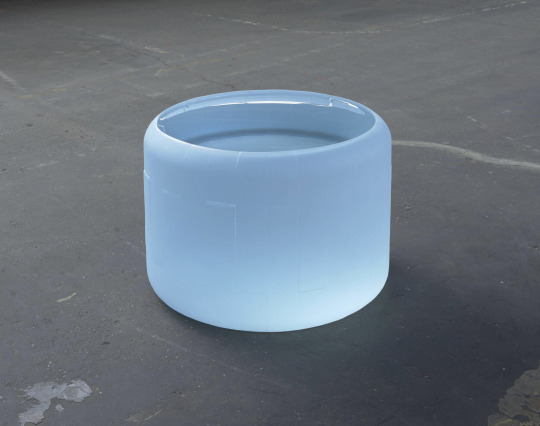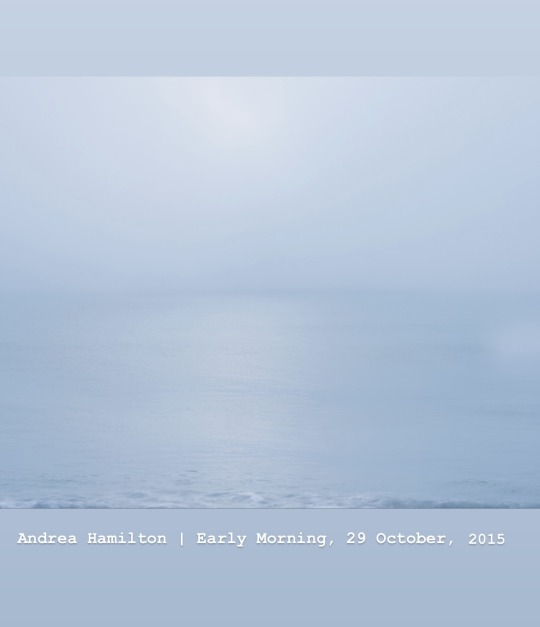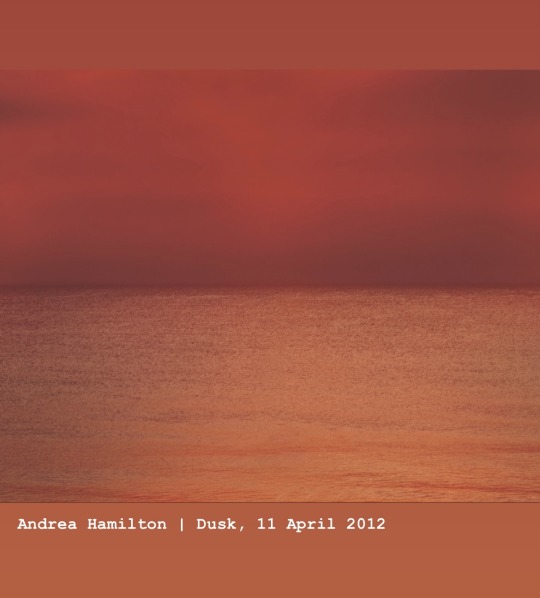Text
Roni Horn
Roni Horn, born on the 25th of September, has produced a body of work involving drawings, photography, installations, sculpture and works based on literature, all questioning and generating uncertainty. Her attention to the specific qualities of certain materials spans all mediums, from the textured pigment drawings to the use of solid gold or cast glass, and rubber. Central to her work are nature, humankind, the weather, literature and poetry.
Horn’s ice-blue sculpture ‘Untitled’ (‘The peeled white body of the beheaded whale flashes like a marble sepulchre; …Slowly it floats more and more away, the water round it torn and splashed by the insatiate sharks, and the air above vexed with rapacious flights of screaming fowls, whose beaks are like so many insulting poniards in the whale. The vast white headless phantom floats further and further from the ship, and every rod that it so floats, what seem square roods of sharks and cubic roods of fowls, augment the murderous din’), is like water, transforms in accordance with its surrounding elements, gradations of sunlight and shadow activate the work.
The conceptual artist and photographer Andrea Hamilton seeks to capture the maximum chromatic variation of the sea. Her documentation of the colour she saw at a particular moment at the same location during the day, resulted in the creation of a unique archive of 20 years. Hamilton’s work places light on the seascape, reflected and refracted to respond to pigments in nature. She sets constant parameters of location and distance of tripod from the water’s edge, centring the frame on the horizon line, which has as a result a collection of monochrome and duochrome seascape photographs.
Image 1: Roni Horn, ‘Untitled’, 2014 - 2016 © Roni Horn, courtesy Hauser & Wirth, London
Image 2: Andrea Hamilton, ‘Library of Sea Colour’, 2000 - present © Andrea Hamilton


#ronihorn#hauserwirth#artistsstudio#contemporaryart#sculpture#londongallery#andreahamilton#fineartphotography
0 notes
Photo

#LivehiphopDaily #24hrhiphopchannel #Repost @iamdjhadouken ・・・ Ladies night edition 👯♀️ Tonight at 9pm there's only one place you need to be, and that in front of your screen tuning in to @theprogressreport101 . @e_hammerrr, @fashiondree, @1kamoni, @og_nya.lee, and @fungirl_jah will be this week's special guests. Hosts: @lalaashep, @bossbritt__, and @djexel. Catch all our special guest interviews by going to www.theprogressreportmediagroup.com or download the @livehiphopdaily app. #TheProgressReport #Atlanta #Wednesday #Live #Interview #Show #EricaHamilton #AndreaHamilton #Kamoni #NyaLee #JahJah #hiphop #video #podcast (at Live Hip Hop Daily) https://www.instagram.com/livehiphopdaily/p/BvQHubEB7Ff/?utm_source=ig_tumblr_share&igshid=qtg2cqd5n602
#livehiphopdaily#24hrhiphopchannel#repost#theprogressreport#atlanta#wednesday#live#interview#show#ericahamilton#andreahamilton#kamoni#nyalee#jahjah#hiphop#video#podcast
0 notes
Photo

Ladies night edition 👯♀️ Tonight at 9pm there's only one place you need to be, and that in front of your screen tuning in to @theprogressreport101. @e_hammerrr, @fashiondree, @1kamoni, @og_nya.lee, and @fungirl_jah will be this week's special guests. Hosts: @lalaashep, @bossbritt__, and @djexel. Catch all our special guest interviews by going to www.theprogressreportmediagroup.com or download the @livehiphopdaily app. #TheProgressReport #Atlanta #Wednesday #Live #Interview #Show #EricaHamilton #AndreaHamilton #Kamoni #NyaLee #JahJah #LiveHipHopDaily https://www.instagram.com/p/BvPOHZhgJ8k/?utm_source=ig_tumblr_share&igshid=1pmospkhmx8xx
#theprogressreport#atlanta#wednesday#live#interview#show#ericahamilton#andreahamilton#kamoni#nyalee#jahjah#livehiphopdaily
0 notes
Photo

Happy bday @normanikordeismom ❤❤❤ thank you for blessing us with your beautiful talented daughter🙌🙏 #fifthharmony #andreahamilton #normanikordei #allybrooke #laurenjauregui #dinahjane #camilacabello #harmonizers
#fifthharmony#laurenjauregui#normanikordei#dinahjane#andreahamilton#allybrooke#camilacabello#harmonizers
1 note
·
View note
Text
Mark Rothko
Mark Rothko, one of the most significant and influential artists of the twentieth century, was born on the 25th of September 1903. He was a pioneer of the New York School, predominantly recognized for his mesmerizing colour field paintings of large scale.
‘I am interested only in expressing basic human emotions – tragedy, ecstasy, doom, and so on.’ Rothko believed that the abstract image could directly represent the fundamental nature of "human drama."
In these works, large scale, open structure, and thin layers of colour combine to convey the impression of a shallow pictorial space. Colour, for which Rothko's work is perhaps most celebrated, here attains an unprecedented luminosity.
His classic paintings of the 1950s are characterized by expanding dimensions and an increasingly simplified use of form, brilliant hues, and broad, thin washes of colour. In his large, floating rectangles of colour, which seem to engulf the spectator, he explored with a rare mastery of nuance the expressive potential of colour contrasts and modulations.
Alternately radiant and dark, Rothko's art is distinguished by a rare degree of sustained concentration on pure pictorial properties such as colour, surface, proportion, and scale, accompanied by the conviction that those elements could disclose the presence of a high philosophical truth.
The conceptual artist and photographer Andrea Hamilton seeks to capture the maximum chromatic variation of the sea. Her documentation of the colour she saw at a particular moment at the same location during the day, resulted in the creation of a unique archive of 20 years. Hamilton’s work places light on the seascape, reflected and refracted to respond to pigments in nature. She sets constant parameters of location and distance of tripod from the water’s edge, centring the frame on the horizon line, which has as a result a collection of monochrome and duochrome seascape photographs.
Image 1: Mark Rothko, ‘Untitled (Red)’, 1969, Private Collection
Image 2: Andrea Hamilton, ‘Library of Sea Colour’, 2000 - present © Andrea Hamilton


#markrothko#newyorkschool#abstractexpressionism#americanart#pacegallery#tatebritain#andreahamilton#fineartphotography
0 notes
Text
Amber is the colour of Thanksgiving

The colour amber which proliferates this season of transition and change, sits on the spectrum between yellow and orange. An in-between colour, glowing in Autumn leaves that shift from green to brown, or the flesh of a cut pumpkin flickering by candlelight, this is the last colour nature offers us before the monochrome stillness of winter. In the urban landscape our traffic lights are painted amber; the electric glint of amber before it turns red warns a speeding car to slow down, and hover.
This radiant colour takes its name from the “jewel of the earth”, amber, revered by the Greeks and dubbed elektron for its capacity to store static energy. These mythical rocks from the sun were first attributed to Halides, the seven nymph daughters of Helios (god of the sun). When Zeus cast their brother Phaethon out of his chariot, they gathered grief stricken around his ashes and turned into poplar trees weeping tears of golden amber.
Translucent and reflective of honeyed light, amber begins its life as oozing sap from a tree, released as a self-healing balm when it is cut, or snaps a branch. This curative property - magically glowing with static energy and the adaptogen succinite - persists even through millions of years of fossilisation. Compressed with time, these brilliant nuggets have been revered through the millennia for their power to heal.
Collected and traded since the Upper Palaeolithic period, 20,000 years ago, amber was so precious that by the end of the third Punic War (149–146 BC), the Romans controlled all known amber trading routes through the Mediterranean. Then in 1691, Persian Christians made amber lenses and spectacles for the first time. By the 18th century colourless amber was prized by scientists who thought amber optics of higher quality to glass. However, as glass optics were harder, the last report on the use of amber glass spectacles dates back to 1835 report from London.
To imagine glasses made of a material so ancient, and to look through the lens of prehistory into the present… it is no wonder this extraordinary material has been dubbed the “time machine.” Although it is solid, and in some cases up to 320 million years old, amber is always in active “process” and sits on a continuum. The hardening of material is known as the copal stage, a chemical processes of polymerization and molecular cross-bonding which continues over millions of years until the hardened resin, or copal, acquires the properties of amber.
Sometimes the sticky resin captures and entombs an insect, and palaeontologists have used amber to study over 1,000 extinct species of insects found perfectly preserved inside. Carried inside its lustrous chambers is life seen on an epochal journey, that disrupts our sense of time.
Over 80% of known amber in the world comes from the Baltic region, and yet no two pieces of amber are the same. With over 400 shades, there are primary and secondary colours of amber, the primary depending on three factors: structural, dispersion of light, and different inclusions. Yellow amber has a rich range of hues, especially honeycomb, cognac and golden, and the word is used to reference a glowing warm feel good colour synonymous with the storing up reserves in the approach to winter. In fact, the word electricity can be traced back to amber, which was known as electron, and it’s capacity to heal is connected to its ability to store static energy.
Worn by teething children or as an aid to those with inflammatory diseases, amber is known to absorb negative energies and transmute them in to positive, thus stimulating the body to heal itself. This quality is known as adaptogen, and takes place on contact with the skin. As it warms, the body starts to absorb the healing element in amber, succinite, lauded for its anti-inflammatory properties and manufactured chemically by the pharmaceutical industry.
Further, the colour itself works on the mind, to stimulate the intellect and induce a positive mental state, akin to the incandescence experienced when gathered around a campfire. It is a pure chroma colour that sits midway between yellow and orange on the colour wheel, although the stone itself varies so dramatically in colour that in certain resinites from the Dominican Republic there are flickers of blue and green. “The greenish blue color observed in some amber from the Dominican Republic and Indonesia is actually fluorescence stimulated by ultraviolet (UV) light… it is in fact a surface fluorescence. Since this amber can be considered a long-wavelength pass filter with a half-pass wavelength at about 530 nm in its spectral transmittance, it does not transmit either UV or short-wave visible light. As this material completely absorbs light in the UV range and strongly absorbs light in the short-wave visible range, the stimulated blue color is confined exclusively to the surface. The amber from this study also showed the Usambara effect, the phenomenon in which color varies with the path length of light through a sample.” Yan Liu, Guanghai Shi, and Shen Wang (Color Phenomena of Blue Amber)
Amber energetically counteracts the darkness, a colour that reassures us all will be well. Fittingly, it originates from the one species on this planet without which there would be no oxygen, no life. Released from a tree’s immune system in response to injury, this extraordinary balm is preserved over time, and reminds us that everything is connected. Just as the tree needs light to synthesise CO2, its capacity to heal itself extends to those lucky enough to grasp a nugget of time frozen sap, golden and translucent, like a little baby sun. Indeed, the specific amber colour we see depends entirely on how the sunlight passes through it.
Amber Time Machine
I lifted to the window a nugget of golden Dominican amber entombing a small stingless bee. The sunlight infused it and illuminated the bee caught forever in flight—gossamer wings outstretched and perfectly preserved down to the last hair. Stark eyes appeared to be gazing at me. I contemplated this lustrous burial chamber and thought how wondrous it would be if we could see what this insect had beheld in its lifetime. Would the vistas of just one day be sufficient to reveal the wonders of life millions of years ago? What was that last fateful day like? And what events had taken place in the eras before this specimen arrived in my hand?
0 notes
Photo



Here are some pictures from the latest lecture that Anthony Downey gave at AH Studio in London on March 9th 2016. His talk was focused on Contemporary Arab from the Middle East. Anthony is Editor-in-Chief of Ibraaz, the leading critical forum on visual culture in North Africa and the Middle East founded in 2011. The long-term ambition of Ibraaz is to contribute critically and creatively to the production of cultural knowledge about contemporary artistic production within the Arab world and beyond. Please see: http://www.ibraaz.org
0 notes